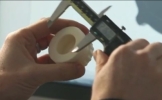From space missions, to building homes, to replacing an 83-year-old woman’s lower jaw, to the robotic arm for a two-year-old child overcoming the effects from a congenital disorder — 3D printing is changing the world. As we move further into the 21st century, researchers are discovering enormous potential for 3D printing technology.
At the University of Hasselt, in Belgium, doctors used a technology called Laser Melting to replace a severely infected jaw bone of an 83-year-old woman. The 3D printing technology, developed by Belgium manufacturer LayerWise, uses titanium powder to replicate the patient’s original bone structure.
 Another manufacturer Stratasys combines Fused Deposition Modeling (FDM) and 3D printing. This allowed medical professionals at Alfred I. duPont Hospital for Children to produce plastic arm supports for a two-year-old child suffering from arthrogryposis — a condition which limits the use of underdeveloped muscles.
Another manufacturer Stratasys combines Fused Deposition Modeling (FDM) and 3D printing. This allowed medical professionals at Alfred I. duPont Hospital for Children to produce plastic arm supports for a two-year-old child suffering from arthrogryposis — a condition which limits the use of underdeveloped muscles.
NASA engineers are innovating new methods for developing 3D technology. Current testing conducted by NASA are designing parts for space rovers the size of Hummers. The test vehicles are adapting 3D technologies to explore mars and other future space missions .
Industry experts agree the potential applications for 3D printing are revolutionary. The cost for basic 3D printers is becoming more affordable. What was once only achieved in research labs funded by venture capitalists is now becoming readily available in consumer markets. In addition to affordability basic 3D printers have improved features for producing higher quality 3D prints. The popular 3D printer Replicator from Makerbot Industries is now selling for $1,749. Other options are the Roland iModela for $899 and the UP! Personal Portable 3D Printer for $1499.
Education Outreach Curriculum Development Coordinator and middle school teacher Liz Arum is using 3D printing to teach young students engineering. Her classes incorporate a variety of open source software programs. The software used by her students to create 3D models are 3dtin, tinkercad, sketchup, blender, and openscad.
For business manufacturers high-end 3D printers can now shape models from various plastics, metal alloys, ceramics, and even food. As the technology improves so too will its impact on manufacturing different products. Business leaders note the technology will not only reduce manufacturing cost but also spark more innovation. The technology allows engineers to experiment with different 3D prototype designs with the touch of a button . . . “Beam me up, Scotty”.

